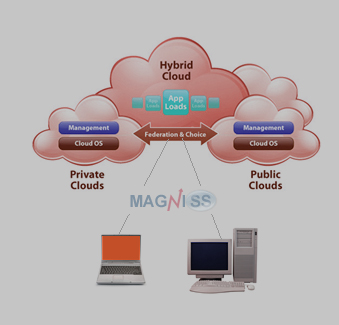Brief Overview of Hybrid SaaS
As technology evolves, companies' quest of finding new ways to reduce cost and complexity of maintaining their IT system grows. Many companies have slowly moved or considering moving their IT system from on premise to the cloud; this has help greatly in keeping up with the fast changing tech world.

|
Software as a service (SaaS), sometimes referred to as "on-demand software", is a software delivery model in which software and associated data are centrally hosted on the cloud. Users typically 'rent' or borrow online software instead of actually purchasing and installing it on their own computers. It is the same situation as people using Gmail or Yahoo mail services, except that SaaS goes much further. SaaS is the foundational idea behind centralized computing: entire businesses and thousands of employees will run their computer tools as online rented products. All of the processing work and file saving will be done on the Internet, with users accessing their tools and files using a web browser.
SaaS has become a common delivery model for many business applications, including accounting, customer relationship management (CRM), management information systems (MIS), enterprise resource planning (ERP), human resource management (HRM) and content management (CM). One of the biggest adoption reasons is the potential to reduce IT support costs by outsourcing hardware and software maintenance and support to the SaaS provider.
|
However, there are many challenges that are present in the SaaS model that have hinders the adoption of SaaS solution.
-
Since data are being stored on the vendor's servers, data security becomes an issue.
-
SaaS applications are hosted in the cloud, far away from the application users. This introduces latency into the environment;
so, for example, the SaaS model is not suitable for applications that demand response times in the milliseconds.
- Multi-tenant architectures, which drive cost efficiency for SaaS solution providers, does not allow true customization of applications for large clients,
prohibiting such applications from being used in scenarios (applicable mostly to large enterprises) for which such customization is necessary.
- Some business applications require access to or integration with customer's current data.
When such data are large in volume or sensitive (e.g., end users' personal information), integrating them with remotely hosted software is costly and/or risky.
- Switching SaaS vendors may involve the slow and difficult task of transferring very large data files over the Internet.
- Loss of performance because of the difference between output internet speed and network speed
- Relying on an Internet connection means that data is transferred to and from a SaaS firm at Internet speeds, rather than the potentially higher speeds
of a firm's internal network.
Hybrid Software as a service (Hybrid SaaS)
This model has arisen in response to the drawbacks of the pure SaaS model to provide the advantages of the SaaS model, while mitigating the potential drawbacks of on premise solution. Users could 'rent' or borrow software instead of actually purchasing and installing it on their own computers, similar to that of a SaaS offering but without needing to share the sensitive company data across the cloud.

|
A Hybrid SaaS model refers to the combination of the SaaS Service Model, with the Hybrid Cloud Deployment model.
The primary motivation for this scenario is organizations who wish to harness the benefits of Software as a Service, but without using public web applications.
Software is deployed into Hybrid Cloud environments and offered on a SaaS basis to organizations, to overcome these objections.
One common example in the SMEs sector, where they would like to harness the financial and technical benefits of SaaS, but cannot host their data outside of their own premise or VPN owing to data confidentiality reasons. No more worries on software upgrades and high yearly maintenances cost. It combines the convenience and flexibility characteristic of most browser-based applications with the speed, power, and rich user experience credited to many server-based, locally run applications. With hybrid SaaS, they can now use the software application without compromising on data security which is well guarded within their premise firewall.
|
Unlike with a browser-based application, hybrid SaaS users install a small application onto their computer. Once the program is running, it appears to the user as a normal Windows application. One of several unique advantages to this application includes its access to the user's local hard drive for real-time data caching. This proprietary data caching, not available in browser-based programs, allows the program to locally store commonly used data for instant retrieval of information without delays caused by Internet traffic, resulting in increased office efficiency at significantly lower costs.
The sustainability of the hybrid SaaS model offers a long-term safety net to SMEs who seek an affordable alternative to traditional server-based and Internet-based solutions without sacrificing the respective speed and power or convenience and flexibility they've come to expect from these less comprehensive models. As it becomes more widely adopted in the future, the hybrid SaaS model will serve to buffer software users from rapid economic declines while still providing the benefits they require from a software solution.
Key Capabilities:
- Realize lower total cost of ownership (TCO) than in pure on-premises deployments.
- Offers flexibility in solving some challenges-inbound filtering, data loss prevention, archiving or encryption-"in the cloud" with others on premises.
- Migrate additional services to a SaaS model at any time.
- Leverage SaaS for providing capacity on demand, coupled with on-premises appliances for solving complex global routing and administration challenges.
Also see Frequently asked questions
|
